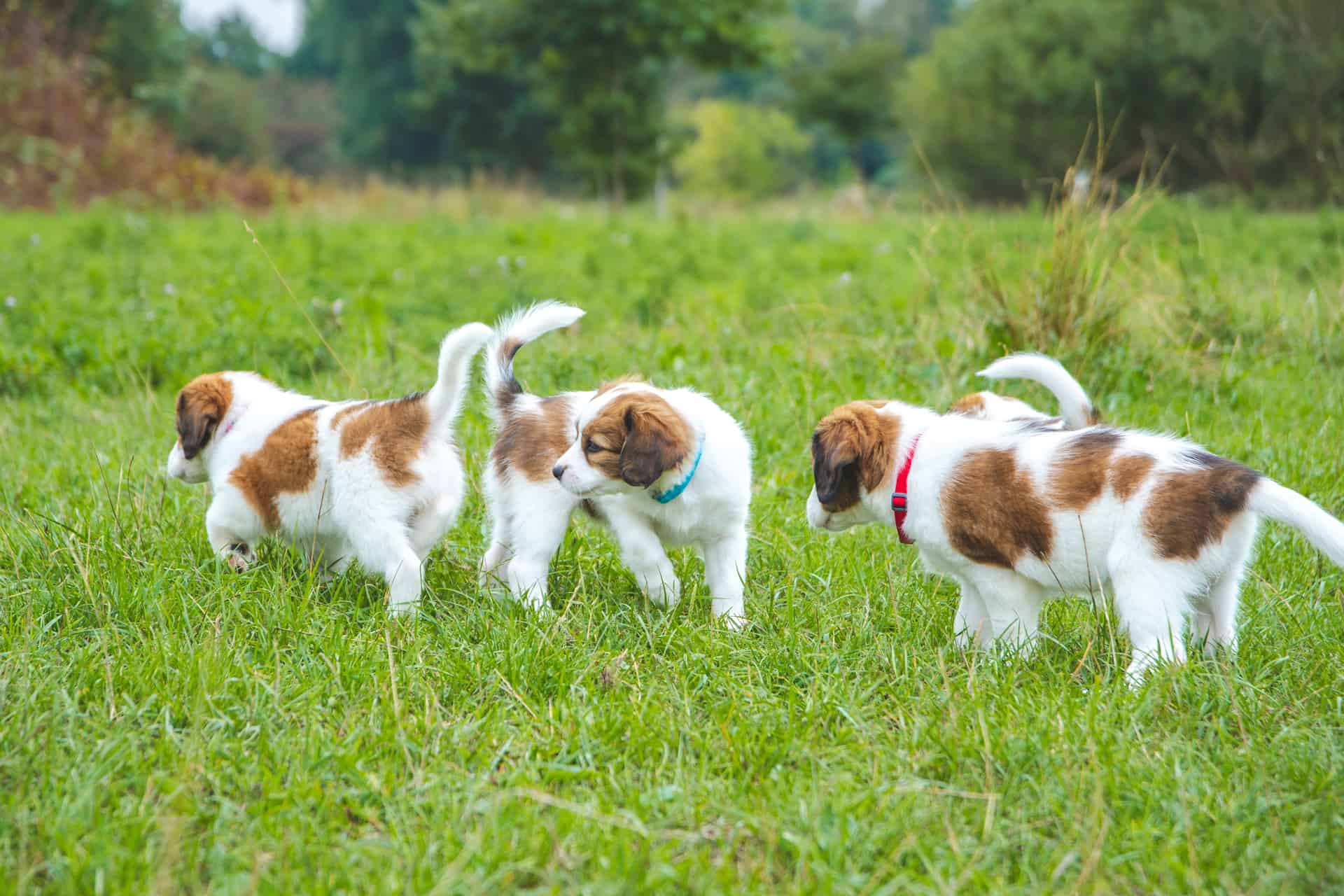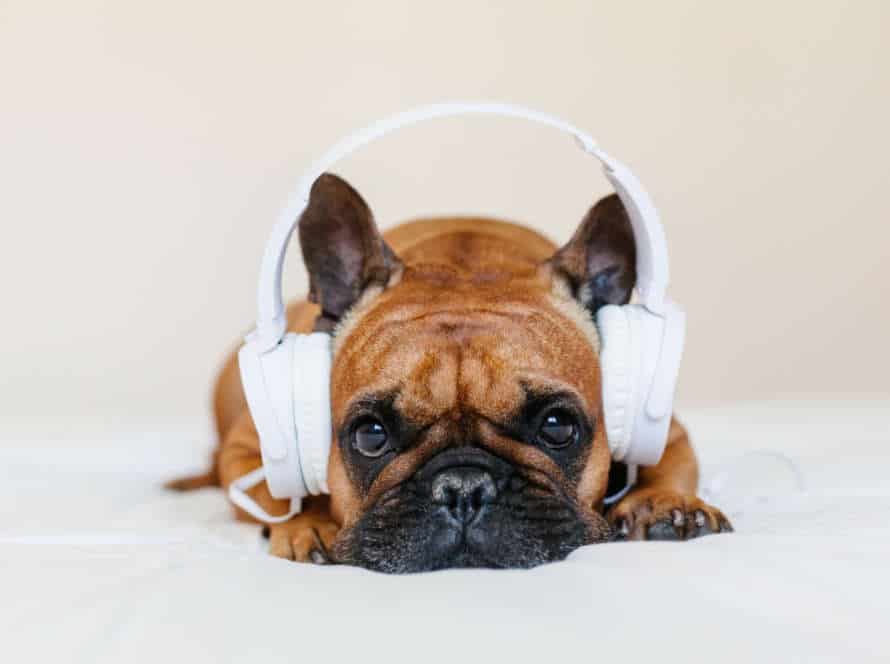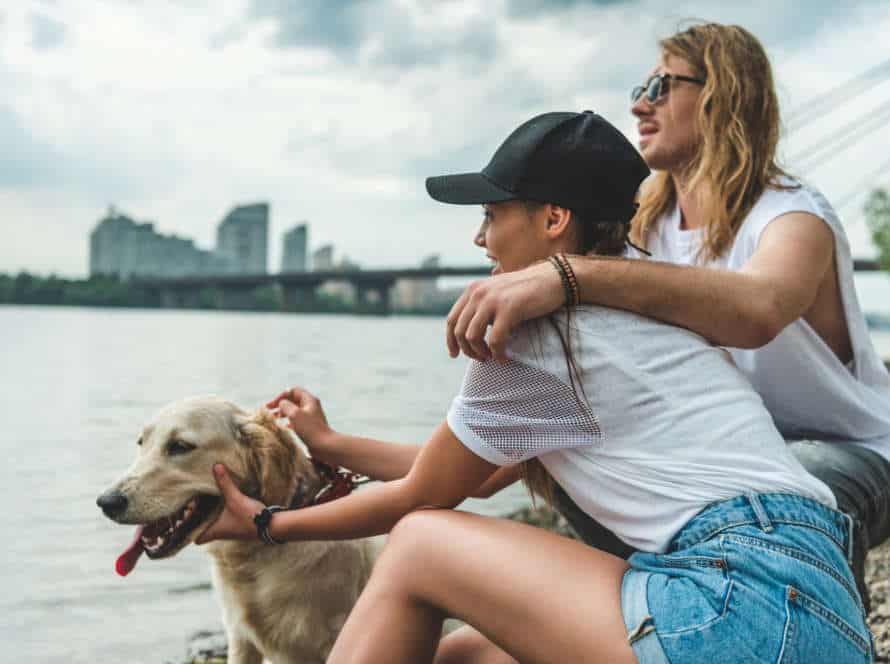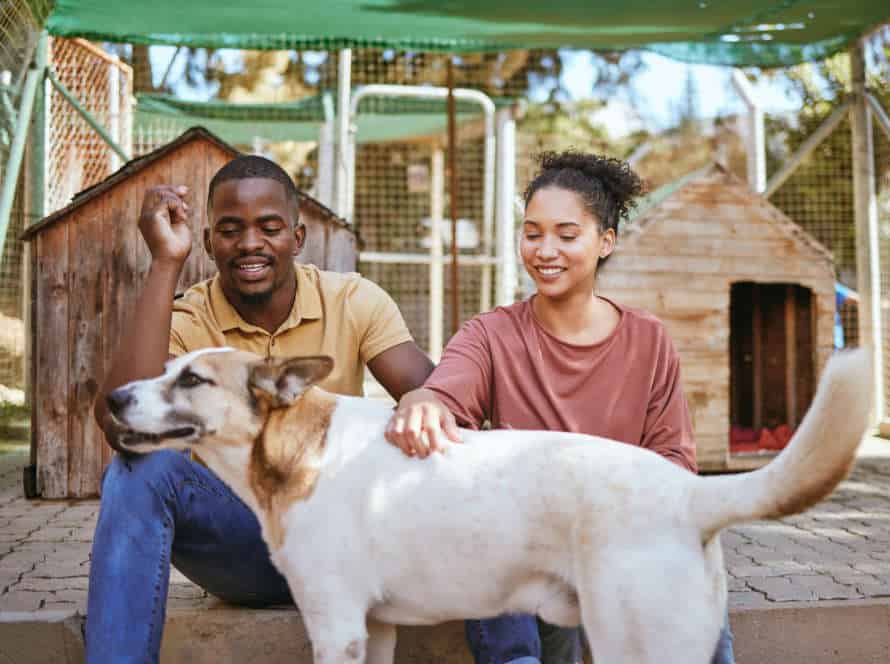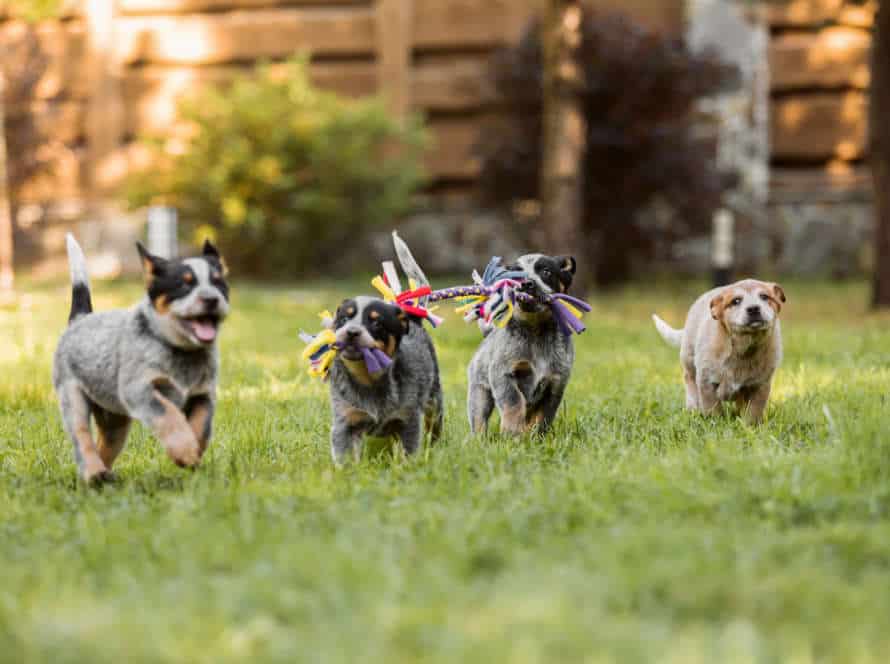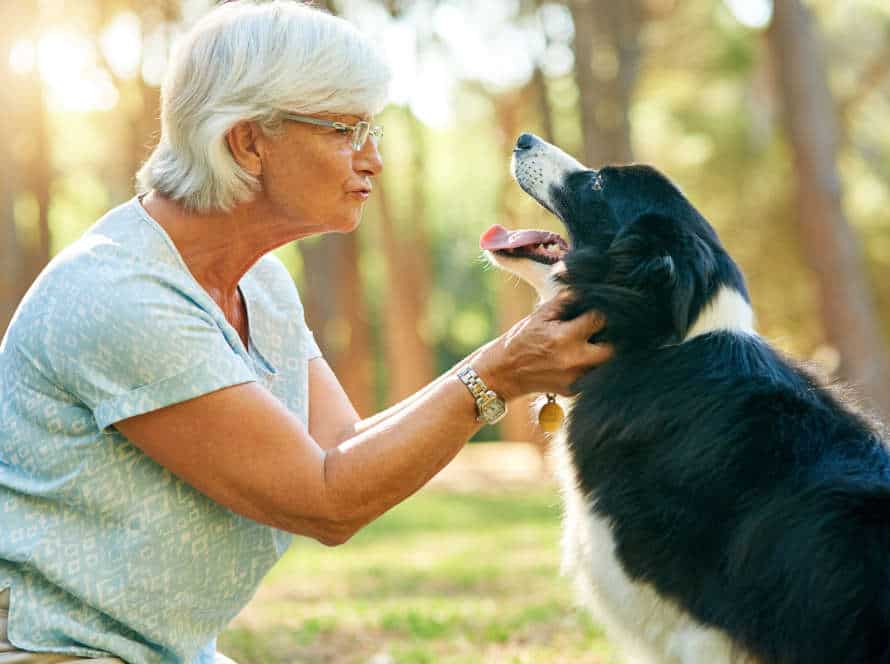Socializing Your Puppy with Other Dogs: Best Practices
Socializing your pup is crucial for its development and can help stop future behavioral issues. Here’s how:
- Start young: Socialization should start when your pup is 3-16 weeks old. That’s when they’re most open to learning and making good connections.
- Choose companions wisely: Pick dogs whose age, size, and temperament match your puppy. Avoid aggressive dogs or those with poor social skills.
- Go slow: Introduce your puppy to other dogs gradually, letting them sniff and explore without pressure.
- Reward good behavior: Give treats, compliments, and love when they do well during socialization.
- Be patient: It takes time and patience. Don’t force it and let your pup set the pace.
- Practice often: Continue socializing with other dogs to keep up positive behavior and avoid backsliding.
Pro tip: Enroll your puppy in puppy socialization classes for a safe, supervised place to learn and socialize.
Why Socialization is Important for Puppies
Socialization is key for puppy development. It builds trust, sets boundaries, and helps pups feel relaxed with people, animals, and objects. Socializing your pup with other dogs, plus humans and animals, is a must for adapting them to their environment.
Let’s take a look at the best strategies for socializing your pup with other dogs.
Benefits of socialization for puppies
Socialization is vital for a pup’s development and has lots of advantages later in life. Here are some reasons why it’s important:
- It helps maintain health. Socializing stops issues such as nervousness and aggression, which can cause physical illness in puppies.
- It boosts behavior. Socialized pups are less inclined to be afraid, aggressive, or destructive when around people and other dogs.
- It offers great experiences. Socialization lets puppies explore the world in a secure environment, leading to a good attitude towards new people or things.
- It improves relationships. Well-socialized dogs are more confident and relaxed, and they love being with other dogs, making it easier to connect with other animals at home or in public parks.
To properly socialize your puppy, introduce them to different situations and people as soon as possible. Start with positive experiences and gradually increase exposure. Pro tip– Consult a professional trainer or vet to make sure you are socializing your pup safely and correctly.
Risks of not socializing your puppy
No socializing your pup can cause behavioral issues in the future. Like aggression, fear, and anxiety. Socializing teaches your pup to interact with other dogs and people in a safe, controlled way. So, it stops issues from popping up later.
Here are the risks of not socializing your pup:
- Fear and Anxiety: Without socializing, your pup might be scared or anxious of other dogs and people. This can lead to aggressive behavior.
- Isolation: Not socializing your pup can make them feel lonely and isolated. This can cause destructive behavior.
- Problems with Training: Pups not socialized may find it hard to learn obedience. They might not be exposed to different social situations and stimuli.
On the other hand, socialization has lots of benefits for puppies. These include better social skills, better health, improved mental wellbeing, and a strong bond with their owners.
The Right Age to Begin Socialization
Socializing your pup is essential for growth. Around 8-10 weeks is when you should start. Perfect timing for them to meet other dogs and learn good habits. Let’s chat about the best methods for socializing a puppy with other doggos!
Factors to consider
When deciding the best age for socializing your pup, there are various things to bear in mind:
- Breed: Different breeds mature at different speeds, so you need to be aware of your pup’s breed and development stage.
- Vaccinations: Make sure your pup has all their vaccinations to keep them safe from sickness before introducing them to other canines.
- Temperament: Notice your pup’s personality and behavior, as some puppies may be more outgoing or timid than others and may require different socialization approaches.
- Environment: Look at the socialization possibilities available to your pup in their environment, such as other dogs in the home, puppy classes, and dog parks.
- Socialization Goals: Consider what you want to get out of socialization, like better sociability, obedience, and less stress.
By considering these elements, you can come up with a custom socialization plan that will work best for your pup’s individual needs and growth stage.
The critical socialization period
Puppies’ socialization period is essential – it starts when they’re 3-4 weeks old and lasts ’til 16 weeks. During this time, pups are more open to new people, animals, and environments. This helps them get the social skills and confidence for their future lives.
Here’s how to socialize your pup with other dogs during that important period:
- Start early! Socialization should start at 3-4 weeks of age.
- Build positive associations by introducing your pup to other dogs in a safe space. Use rewards and praise to encourage good behavior.
- Go slow – don’t give your pup too much at once. Pay attention to their body language for signs of fear or stress.
- Be consistent – as your pup grows up, keep socializing them to make sure they’re confident and adjusted.
Steps to Socialize Your Puppy with Other Dogs
Socializing your puppy is a must! They need to get comfy with other dogs while they’re young. This will help avoid any issues in the future. Here are the steps to take:
- Introduce your pup to other dogs in a safe, controlled environment.
- Make sure it’s a positive experience for your pup.
- Continue to socialize your pup regularly.
- Reward them with treats and praise.
Start slow and steady
Socializing your puppy with other pooches is essential for their physical and mental growth. Here’s the plan to follow for optimal results:
- Begin with controlled meetups: Introduce your pup to an obedient, vaccinated adult doggy in a restricted area, like a fenced-in yard, where you can keep an eye on them.
- Utilize positive reinforcements: Offer your puppy plenty of praise and treats when they display good behavior. If your pup becomes nervous or aggressive, take them away from the environment in a gentle, swift manner.
- Step-by-step increase exposure: With time, you can steadily increase your pup’s contact with other doggies, like in a dog park or playdates with other puppies. Remember to stay attentive and don’t force the interactions.
- Observe body language: Remember to observe your pup’s body language, such as tail and ear position, as it can show their comfort level. Keep your pup in a leash to ensure they’re safe.
Pro tip: Start slow and steady when socializing your pup with other dogs! You can help your pup build healthy relationships while keeping them secure.
Choose safe environments
Choosing safe places is key when introducing your pup to other dogs. Here are some tips:
- Go to dog-friendly spots like pet stores, beaches, and dog parks.
- Avoid taking your pup to overcrowded, noisy places like concerts or festivals.
- Introduce your pup to other dogs gradually, starting with calm and friendly ones you trust. This can help prevent negative or aggressive encounters.
- Closely watch your pup’s body language and behavior during socialization. If they seem scared or nervous, take them away from the environment and try again later.
- Supervise your pup when around other dogs.
- Remember that socialization needs patience and persistence. By choosing safe environments and following these tips, your pup can form positive and healthy relationships with other dogs.
Watch for signs of fear or aggression
Socializing your puppy is key. Look for signs of fear or aggression. These include growling, barking, cowering, trembling, and biting. To have a positive experience:
- Start early – 3 to 14 weeks is best.
- Introduce gradually – in a controlled environment like a dog park or obedience class.
- Supervise interactions and intervene if necessary.
- Use positive reinforcement such as treats and praise.
- Be patient – every pup is different and it may take time to feel comfortable.
Socializing with Specific Types of Dogs
Socializing your puppy is crucial for them to become friendly and confident. Think about what type of dogs you introduce your pup to. Here are the best practices for socializing puppies with:
- Other pups
- Adult canines
- Larger breeds.
Small dogs
Socializing small pups with other breeds is a must to prevent issues like fear, anxiety, and aggression towards other pups. Owners of little breeds need to be cautious and take steps for safety and a positive experience. Here are some tips for socializing your tiny pup with other kinds of dogs:
- Start off slowly and gradually let your pup meet others.
- Pick doggies that are friendly and gentle.
- Observe signs of fear or aggression, e.g. growling or snarling.
- Keep your pup on a leash or in a fenced-in area.
- Reward good behavior – like approaching and sniffing other dogs without fear.
Socializing your pup with other dogs is important for their health and joy. With care and patience, you can help them become confident and kind companions.
Large dogs
It is important to socialize your large pup with other dogs for them to grow up friendly, self-assured and obedient.
Here are the best tips for socializing your dog with other pooches:
- Start early – as soon as possible, ideally before 12 weeks old.
- Go slow – introduce them in one-on-one settings before moving on to a group.
- Use positive reinforcement – give treats and show approval for good doggy behavior, like playing nicely with others.
- Observe – keep an eye on your pup’s body language and take them away if they seem uncomfortable or hostile.
- Safety first – always watch your large dog around other dogs and keep them on a lead in public until their social skills are secure.
Older dogs
Older pooches need a different way to socialize than puppies. But, it’s never too late to assist your pup in developing social skills, and making new canine friends! Here are some tips on how to socialize older dogs with certain kinds of pups:
- Socializing with puppies: Introduce them gradually, and observe their interaction very closely.
- Socializing with older dogs: Let them play and exercise together, but ensure that their energy and play styles match.
- Socializing with small dogs: Teach the older pup to be gentle and avoid rough play when around smaller breeds.
- Socializing with larger dogs: Watch the interaction between the larger and older dog, to prevent any potential aggression. Praise positive interactions and encourage gentle play.
With dedication, patience, and positive reinforcement, you can help your older dog learn to socialize and relish the company of other doggos.
Puppies
Socializing your pup is key for their growth and health. Here’s how to socialize with different kinds of dogs:
- Small dogs: Pups may see small dogs as prey, so watch their interactions and intervene if needed. Increase their playtime gradually as they get used to each other.
- Large dogs: Pups may be scared of bigger dogs, so start by introducing them from afar. Supervise them and don’t leave them alone.
- Senior dogs: Older dogs may not have the same patience for puppies. Monitor their interactions and limit their playtime.
- Unfamiliar dogs: Pups may be leery of unfamiliar dogs, so introduce them slowly and let them get close at their own pace. Don’t force it and always supervise playtime.
Pro Tip: Start socializing your pup early and continue doing so throughout their first year.
Tips for Socializing Your Puppy with Other Dogs
Socializing your puppy with other dogs? Important! Follow best practices. Keep your pup and other pups safe. Know the best practices for introducing your pup to others. Create positive social experiences. Make a big difference in future pup behavior. Here’s some key tips for socializing your puppy with other dogs.
Positive reinforcement
Positive reinforcement is an awesome way to get your pup used to being around other dogs. Rewards are better than punishments for doggos. Positive reinforcement makes it much more fun for your puppy and builds their confidence.
Here’re some tips:
- Treats! Give small, soft treats when they behave around other pups.
- Praise! Use kind words, cuddles, and positive body language.
- Social groups! Join a group or host a playdate with other pooches.
- Playtime! Encourage play to help them learn social skills.
Pro tip: If your pup is scared, don’t punish. Give them space to take a break and try again later. It takes time and patience, but it’s worth it.
Observe and respond to body language
Socializing your puppy with other dogs? Observe their body language! It’ll tell you if they’re comfy, anxious, aggressive, or submissive. Here are some body language cues to watch for:
- A wagging tail? Could be excitement, happiness, anxiety, or fear.
- A relaxed body? Comfortable and open to socializing.
- Raised fur, growling, bared teeth? They feel threatened or defensive.
- Cowering, whining, yelping? Fear or anxiety.
- Notice any discomfort or nerves? Give pup some space! Don’t force interactions they aren’t ready for.
Pro-tip: Supervise your pup when socializing. Be prepared to step in if needed.
Teach basic obedience commands
Teaching your pup basic obedience commands is a must to socialize them with other dogs. Here are some helpful tips:
- Start small – like “sit,” “stay,” and “come.”
- Be consistent – use the same tone and hand gestures each time you give a command.
- No distractions – start in a quiet, low-distraction environment first.
- Positive reinforcement – praise and treat your pup when they obey.
- Patience – teaching your pup takes time and repetition.
By teaching them these commands, you’ll lay the ground for positive socialization with other dogs.
Common Socializing Issues and Solutions
Socializing your pup is a complex task. Puppy aggression, anxiety, fear, and hyperactivity can occur. To build a positive social setting for your pup, you should know the causes of these issues and the best methods to address them. Here, we will discuss the top socializing problems and how to solve them.
Fear and anxiety
Fear and anxiety can affect socializing a puppy with other dogs. But, there are ways to help. Here are the best practises:
- Start off small. Introduce your pup to vaccinated, calm adult dogs.
- Keep an eye. Supervise your puppy’s body language and intervene if needed.
- Reward good behavior. Praise and give treats as your puppy interacts with other dogs.
- Increase exposure. Gradually make socialization sessions longer and more intense.
- Bring comforts. Have familiar items like blankets or toys to help ease your pup’s anxiousness.
- Be patient, consistent, and positive.
Pro tip: If your puppy is still fearful or anxious, seek help from a trainer or behaviorist.
Aggression
Aggression is a common problem when puppies socialize with other dogs. To socialize your pup, introduce them in a controlled setting and use positive reinforcement training. Here are best practices to socialize your pup and avoid aggression:
- Reintroduce dogs in a controlled environment. Start with a calm, friendly and non-aggressive dog in a neutral space. Keep it short and supervised.
- Use positive reinforcement. Give treats, toys or verbal praise when your pup exhibits good social behavior, like sitting or not growling.
- Avoid physical punishment. Don’t punish or yell at your pup for aggressive behavior. This can make their aggression worse and harm your relationship.
- Seek professional help. If your pup’s aggression continues, seek help from a trainer or behaviorist. They’ll create a tailored plan for your pup.
Over-socialization
Owners of pets may face an issue with over-socialization of their puppies. This happens when too many dogs are introduced or the pup has too many interactions at one time. This can cause over-stimulation and, in some cases, aggressive behavior with other dogs.
To prevent this, follow these steps:
- Introduce one dog at a time.
- Select dogs with a calm temperament and good behavior.
- Let the pups sniff each other. Be ready to intervene if needed.
- Don’t push a puppy outside their comfort zone.
- Don’t make them interact with unfamiliar dogs.
- Socialization takes patience and consistency.
Socializing Your Puppy During COVID-19
Socializing your pup is key for their growth. But, with the pandemic, it can be tricky. Fear not, there are still ways to make sure your pup gets the socialization they need! Here we’ll go over the top tips for puppy socializing during this time.
Tips for socializing while social distancing
Socializing your pup during the COVID-19 pandemic can seem hard, but it’s still doable! Here’re some tips:
- Virtual socialization: Have virtual playdates with other pup owners and their doggies. Let them meet through video chat and be supervised.
- Backyard play: Set up a playdate with another pup in your yard. Make sure to keep your distance and stay safe.
- Leash walks: Take your pup for a walk in busy areas. Keep them on a leash and away from other people and pups.
- Training classes: Sign up your pup for online obedience or training classes. Let them meet other canines and learn new tricks.
Pro tip: Socializing your pup is essential for their physical and mental health. Follow social distancing rules and let them grow gradually.
Virtual training and socialization resources
COVID-19 has made virtual dog training & socialization resources popular with pet owners. Here are the best virtual ways to socialize your pup:
- Online puppy classes: Get training & exercises from home.
- Virtual playdates: Zoom or Skype with other pet owners.
- Social media groups: Exchange tips & advice with other dog owners.
- Training apps: Use phone/tablet apps to guide your pup through training & games.
When socializing with other dogs, follow these best practices:
- Choose a safe, controlled environment.
- Introduce puppies gradually & supervise their interactions.
- Keep sessions short & positive. End if either pup is uncomfortable/aggressive.
- Reinforce good behavior with rewards & positive reinforcement.
Pro-tip: Virtual resources help, but it’s essential to socialize your pup in real-life situations with other dogs & people.
Socializing with dogs and people outside of your household
Socializing your puppy with COVID-19 can be tough. But with the correct practices, you can make sure your pup has positive experiences with other dogs and people outside your home. Here are some tips to safely socialize your pup with other dogs and people:
- Invite a few trusted people to your home or meet up in a public area with one or two dogs.
- Keep social distancing; remain 6 feet away from each other.
- Use positive reinforcement techniques. Give treats and praise for good behavior.
- Keep away from crowded dog parks or gatherings of people.
- Be alert. Monitor your puppy’s body language and intervene if needed.
By following these tips, your pup will have positive experiences and good socialization skills, even during the pandemic.
Conclusion
To sum it up, socializing your pup with other pooches is essential for a sound and content life. It’s best to begin early, use positive reinforcement, stay in a controlled space, and be consistent and patient.
As a pet parent, it’s your duty to ensure your pup’s social experiences are both safe and positive. This’ll help grow their confidence, teach them proper communication, and allow for a stronger bond with you.
So, don’t hesitate if you’re a new puppy parent! Put in the effort to socialize your pup with other dogs – it’ll be worth it with a well-adjusted and satisfied pup!
Frequently Asked Questions
Q: When should I start socializing my puppy with other dogs?
A: It is recommended to start socializing your puppy as early as 8-16 weeks old. This is a critical time period where your puppy is most receptive to new experiences and is important to expose them to other dogs and people.
Q: How should I introduce my puppy to other dogs?
A: The introduction should be gradual and supervised. Start by introducing your puppy to well-behaved dogs in a neutral territory, such as a park. Keep your puppy on a leash and reward them with treats for good behavior.
Q: What if my dog is shy or anxious around other dogs?
A: Gradual exposure is key. Start by introducing your dog to a calm and friendly dog in a controlled environment. Do not force your dog to interact and make sure to reward positive behavior. Consider seeking professional help if your dog has severe anxiety or aggression towards other dogs.
Q: How often should I socialize my puppy with other dogs?
A: Regular socialization is important for your puppy’s development. Aim for at least once a week, but depending on your puppy’s personality and schedule, socialization opportunities can vary.
Q: What should I do if my puppy is being too rough during playtime with other dogs?
A: Keep an eye on the playtime and intervene if your puppy is being too rough. Avoid scolding or punishing your puppy, instead redirect their behavior with a toy or a brief time-out.
Q: Should I continue socializing my dog as they get older?
A: Absolutely! It’s important to continue exposing your dog to new experiences and people throughout their life. This will help prevent anxiety and fear towards unfamiliar situations later on.

